Common menu bar links
NOTICE
The Aboriginal Canada Portal closed February 12, 2013. The Digital Aboriginals of True North Turtle Island have intervened. Please visit this web page for more information.
b. Internet Access at the HouseholdBased upon 2002 & 2003 Connectivity Survey Responses Only
Based upon 2002 & 2003 Connectivity Survey Responses Only
At the household level, 85% of Aboriginal communities are connected to the Internet in some way. i. Toll-Free Internet Access at the Household LevelBased upon the communities that have Internet Access from the table above
Based upon 2002 & 2003 Connectivity Survey Responses Only
When we exclude the number of communities with households that incur long distance charges for Internet services, the numbers change significantly. Also, of the 630 respondents that indicated that households within their communities have Internet Access, 6 did not specify the method of connection. Therefore, as a result the ACP survey team has reduced the total number of communities with households that have Internet Access from 630 to 624. At the household level, more than 2/3s of connected Aboriginal communities have toll-free access to the Internet. It should be noted that our primary contact at the community was the Community Administration Office (CAO). Through this contact we attempted to ascertain what communication technologies were available to the general residential community. ii. Method of Internet Access at the Household Level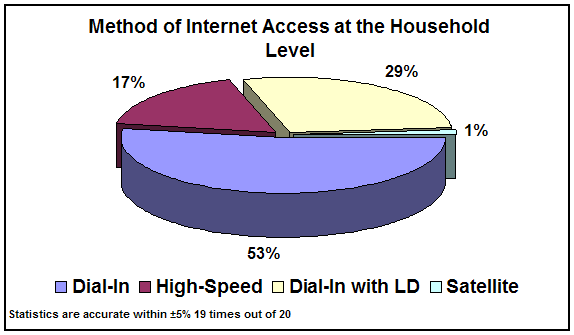
Based upon 2002 & 2003 Connectivity Survey Responses, CAP and SchoolNet sites
We have defined high-speed internet access to include ADSL, Cable, ISDN, T1, and Wireless. Of the communities with households connected to the Internet, 82% of those communities have households that use analog dial-in modems to connect. Of this 82%, 35% of those (29% of the total) do so while incurring long-distance telephone charges. While a community that connects to the Internet via low-speed modem while incurring long-distance charges is technically “connected”, the ability for that connection to be used for research, e-commerce or educational purposes is severely limited. The ACP survey team refers to “connected communities” as those who do not incur long distance telephone charges for its use. 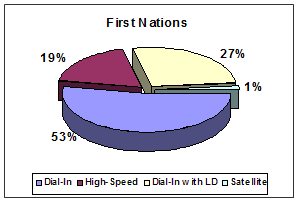 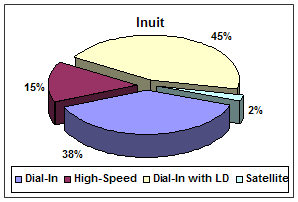 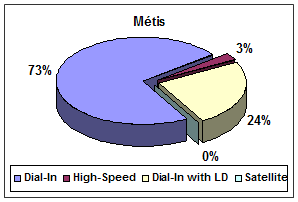
iii. Availability of Internet Access at the Household Level by Province/Territory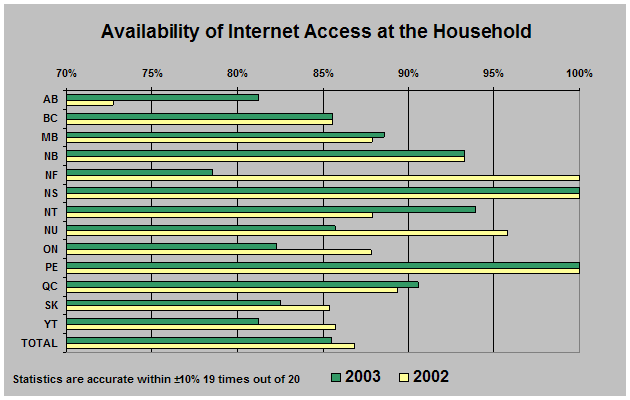
Based upon 2002 & 2003 Connectivity Survey Responses, CAP and SchoolNet sites
The above chart indicates the ability to connect to the Internet if provided with the appropriate equipment at the household. The level of connectivity varies from province to province but averages at just over 85% for all provinces for both years. The decreases from 2002 to 2003 occurred as a result of differences in sampling sizes. It should be noted that ALL households within Aboriginal communities in Nova Scotia and Prince Edward Island had Internet Access in both years. iv. Availability of High-Speed Internet Access at the Household Level by Province/Territory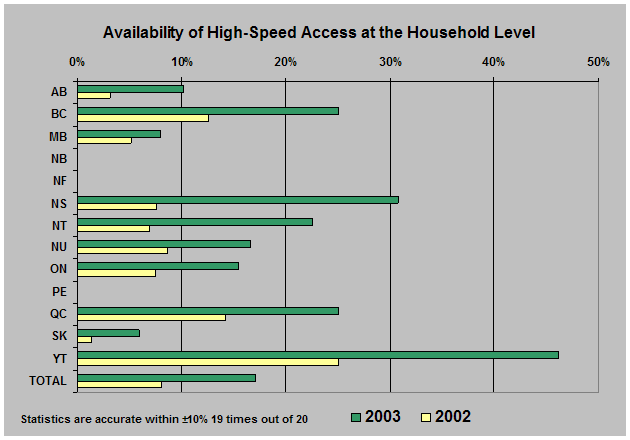
Based upon 2002 & 2003 Connectivity Survey Responses, CAP and SchoolNet sites
We have defined high-speed internet access to include ADSL, Cable, ISDN, T1, and Wireless. When we look at the availability of high-speed internet access, the picture is quite different and variable. The above chart tabulates the percentage of participating communities that indicated the availability of high-speed Internet services at the household level. The level of availability of high-speed connectivity varies greatly from province to province and has increased dramatically from 8% in 2002 to 17% in 2003, with the greatest annual gain coming from the Yukon whereby the availability of high-speed internet access rates increased from 25% in 2002 to 46% in 2003. Households within Aboriginal communities surveyed in New Brunswick, Newfoundland, and Prince Edward Island do not have high-speed internet access available to them. Most satellite Internet systems currently in place are one-way systems that require a traditional analog dial-in modem for uploading. For that reason satellite systems have been excluded from the definition of high-speed. v. Comparing Household High-Speed Internet Access Rates by Population Group
Based upon 2002 & 2003 Connectivity Survey Responses Only
We have defined high-speed internet access to include ADSL, Cable, ISDN, T1, and Wireless. It was no surprise that we identified households within larger communities as being better connected to high-speed Internet services. As the cost of providing these services decrease and the number of customers who demand high-speed Internet services increase we should see households within smaller communities being offered high-speed Internet services. High-Speed Internet Access rates have on average doubled from 2002 to 2003 for each population group. This shows that there exists an ever increasing demand for this high-speed internet service for all households within Aboriginal Communities. vi. Household Internet Service Provider (ISP) Subscribers
Based upon 2003 Connectivity Survey Responses Only
When asked the question; "In your opinion, what percentage of community residents currently subscribe to an ISP service?" 90% of the responses were in the 0 to 50% range. vii. Household Access to Satellite TV
Based upon 2003 Connectivity Survey Responses Only
Similarly, when asked the question; "What percentage of community residents currently subscribe to a satellite television service?" the majority of responses were in the over 50% range. We can only speculate, but feel that these high numbers demonstrate a propensity to use new technology. |
